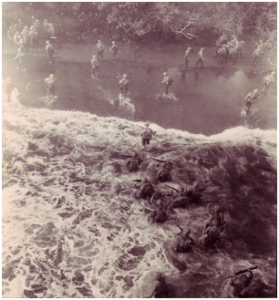ROAD TO TOKYO COUNTDOWN: EXHIBITS WITHIN ISLAND HOPPING
As we continue down the Road to Tokyo and through the Island Hopping gallery, we come next to the Tarwara exhibit, which tell of the first major operation of Central Pacific war. The operation involved U.S. forces invading the Gilbert Islands in order to secure airstrips, with the main target being the Tarawa Atoll.
The operation consisted of airstrikes, naval bombardment, and, most remarkably, the first widespread use of the amphibious Landing Vehicle Tracked to breach coral reefs – a strategy that was not expected by Japanese. The operation, however, resulted in heavy casualties, as the US had difficulty overcoming Japanese defenses and experienced limited success with air and sea bombardment. Victory was ultimately achieved, though the high cost of the invasion stirred controversy. Tarawa was a harbinger of things to come in Central Pacific fighting.
The Island Hopping gallery within Road to Tokyo has been made possible through a generous gift by the James S. McDonnell Family Foundation and Mr. and Mrs. James S. McDonnell III.
Donor Spotlight: Mr. and Mrs. James S. McDonnell III
James and Elizabeth McDonnell have had a great interest in the Pacific Theater of World War II. In particular, Elizabeth McDonnell’s father, John M. Hall, served in the war in the U.S. Navy on an LST in the South Pacific. James’s uncle served with the U.S. Army Medical Corps, was stationed in Fiji and participated in the Okinawa campaign. James also had a first cousin who fought in the war in General Patton’s 3rd Army in Europe as well as several other relatives in the U.S. Army and Navy during WWII.
James comes from a long and proud history of military industrial production! His father, James Smith McDonnell, Jr., an American aviator and engineer, founded the McDonnell Aircraft Corporation in 1939 in St. Louis, MO. During WWII, business expanded exponentially, with around 400 employees in 1941 and more than 5,000 during peak wartime production. During the war, McDonnell Aircraft manufactured 7 million pounds of aircraft parts, including tails and engine cowlings for Boeing bombers and Douglas transports.
The McDonnells first became involved with The National WWII Museum through meeting Hugh Ambrose, son of founder Stephen Ambrose and a member of the Museum’s Institutional Advancement department. As a result of the meeting with Hugh, the McDonnells participated in the Museum’s Pacific Battles Tour in February 2011. Since that intial trip, the couple has traveled on both the Museum’s D-Day 70th Anniversary Cruise and the Masters of the Air Tour.
Aside from their participation in the Museum’s educational tours, the McDonnells chose to make a very generous gift to the Museum’s Road to Victory Capital Campaign in 2011. James states that they chose to name this gallery space because while “everyone knows about D-Day in Normandy, in the Pacific there were 126 opposed D-Days, all of which were important in winning the war against Japan.” He and Elizabeth strongly believe that the importance of World War II is a story that must be told and preserved. James states, “WWII saved the world. Its history should be preserved so that future generations will appreciate the accomplishments and sacrifices made by our troops of all services.” The National WWII Museum is thankful for James and Elizabeth McDonnell and the McDonnell Family Foundation for their outstanding role in fulfilling the Museum’s essential mission of sharing the stories of the Greatest Generation with new audiences.
- Posted :
- Post Category :
- Tags :
- Follow responses to this entry through the RSS 2.0 feed. You can skip to the end and leave a response. Pinging is currently not allowed.





Leave a Reply